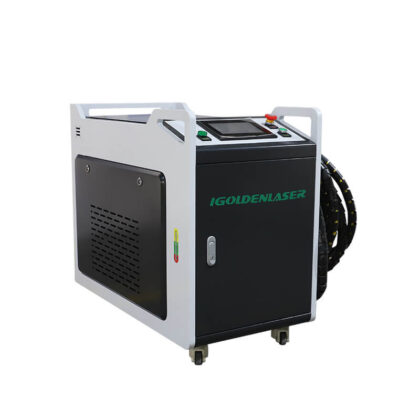Laser Rust Removal Machine in 2025
A laser rust removal machine is a laser cleaning system designed to remove oxide layers, rust, and contaminants from metal surfaces without damaging the substrate. It typically uses a high-power laser (often a fiber laser) to deliver short pulses that selectively affect the rust and oxides while leaving the base metal largely intact.
Category: Laser Machine>>Laser Cleaner
Response time: Within 1 hour
Supply Ability: 300 sets/month
Price: $5000-$8000
Description
Laser Rust Removal
Cleaning metal with a laser cleaning machine is considered as the most reliable and effective way to remove the dust, rust, oil stain, and grease on the metal surface. This handheld laser cleaning machine adopts stable laser source and high-quality laser beam. It can remove multiple types of contaminants from aluminum, steel, carbon steel, and other metal.
The use of high frequency high energy laser pulse irradiate the workpiece surface, make the surface oil, rust or coating instantaneous evaporation or stripping, high-speed and effective cleaning object surface attachment or surface coating, so as to achieve a clean cleaning object process.
It is characterized by no damage to the parts matrix, no consumables, energy saving and environmental protection, to meet the requirements of complex modeling and fine positioning in the field of industrial processing, to achieve a higher cleaning effect and a lower overall cost of production benefits.
Price Range: $6000.00 – $10000.00
Now the affordable portable handheld laser cleaning machine for sale at cost price.




Hand-held cleaning laser head



Laser Rust Removal Application
Laser cleaning machines have been used in many industries such as aviation, aerospace, rail transit, shipbuilding, automobile, electronic industry, and many more. It could be efficiently used for rust removal on bridges, and large metal facilities, such as stadiums, factories, and many other metal structures.
Samples
> Rust removal on metal surface;
> Surface paint removal treatment;
> Surface resin, oil, stains, dirt cleaning;
> Surface coating, coating removal;
>Pretreatment of welding surface/spraying surface;
> Removal of dust and attachments on the surface of stone statues;
> Rubber mold residue cleaning.




CLEANING PERFORMANCE DATA
| Substrate | Surface | Effective focal depth (mm) | Standard cleaning efficiency (mm/min) | High-speed cleaning efficiency (mm/min) | Effect |
| Cast iron | Severely corroded 0.08mm | >35 | 2000 | 3000 | The surface is clean and the substrate is not damaged |
| Carbon steel plate | Moderate rust 0.5mm | >40 | 1800 | 2400 | The surface is clean and the substrate is not damaged |
| Stainless steel | Surface oil, slight rust | >50 | 2000 | 3000 | The surface is clean and the substrate is not damaged |
| Mold copper gear | Moderately oily, with iron filings attached | >45 | 2000 | 2300 | The surface is clean and the substrate is not damaged |
| Aluminum plate | Oxide, surface fouling | >35 | 2000 | 2300 | The surface is clean and the substrate is not damaged |
Portable Laser Rust Remover Features:
- Non-contact cleaning, do not damage parts matrix;
- Precision cleaning, can realize the precise location, accurate size selective cleaning; High cleaning efficiency, save time; u
- Don’t need to use any chemicals and cleaning fluid, basic for solid waste powder after cleaning, small volume, easy to store, can easily solve the problem of chemical cleaning;
- Simple operation, can be hand-held or cooperate with manipulator automation cleaning;
- Of human body engineering design, the operation labor intensity is greatly reduced;
- Laser cleaning system is stable and almost no maintenance;
Laser Rust Removal FAQ
- Laser interaction: A pulsed laser delivers energy to the rust and oxide layer. The absorbed energy causes rapid heating and micro-explosions that ablate the oxide from the surface.
- Selective removal: Rust layers (iron oxides) have different absorption properties than clean steel, enabling selective removal with proper wavelength and pulse settings.
- Debris management: The process creates small particulates and oxide debris that are typically carried away by a suction system or water-assisted cleaning to keep the surface clear.
- Substrate preservation: With appropriate parameters, the underlying metal remains undamaged and free from unwanted etching.
When evaluating machines, these are the main parameters and features to check:
| Spec / Feature | Why It Matters |
|---|---|
| Laser Power (Wattage) | More power lets you clean faster, larger surfaces, or heavier rust layers. Lower power is okay for delicate work. |
| Laser Type / Mode (CW vs Pulsed / Modulated) | Pulsed or modulated lasers allow more control, reduce heat build-up, better for fine work. CW (continuous wave) lasers are often simpler, sometimes less expensive. |
| Wavelength | Most industrial rust-removal lasers are around 1064-1080 nm (fiber lasers). This affects absorption, efficiency, safety. |
| Beam quality / Scan Width | How wide a strip it cleans, how fast (scan speed), how precise. |
| Cooling | Water cooling vs air cooling. Higher power usually needs water cooling. Keeps the machine and optics from overheating. |
| Mobility / Handheld vs Bench / Fixed | Do you need to move it around or treat large, fixed surfaces? Portability adds cost/complexity. |
| Safety features | Eye protection, interlocks, shielding, proper ventilation for fumes/particles. Lasers are hazardous. |
| Power supply / voltage | Be sure your facility can supply the correct voltage, phase, etc. Some machines need 220-240V single or three phase. |
| Maintenance & Consumables | Lens protection windows, filters, spare optics. Also, energy costs and training. |
Laser rust removal machines have become increasingly accessible in 2024-2025, with prices ranging from $3,800 to $52,000, from low-power removers to high-power cleaners to automatic rust removing robot.The best handheld laser rust removal machines are available for sale at affordable prices, ranging from $6,000 to $16,800
The versatility of laser rust removal machines has led to their adoption across numerous industries, each finding unique applications that leverage the technology’s specific advantages.
Automotive Industry In automotive applications, laser cleaning has revolutionized both manufacturing and restoration processes. During production, these machines prepare surfaces for welding, remove scale from stampings, and clean molds used in plastic and rubber component manufacturing. In the restoration market, classic car enthusiasts and professional restoration shops use laser cleaning to remove rust, paint, and other contaminants from vintage vehicles without damaging original metal surfaces.
Aerospace and Defense The aerospace industry demands the highest levels of precision and quality control, making laser cleaning an ideal fit. These machines are used for preparing surfaces before critical welding operations, removing thermal barrier coatings from turbine components, and maintaining sensitive equipment without introducing foreign materials or causing dimensional changes.
Marine Industry Ship maintenance and offshore equipment servicing have been transformed by laser cleaning technology. The ability to remove marine growth, corrosion, and protective coatings without generating waste or requiring special disposal procedures makes laser cleaning particularly valuable in marine environments where environmental protection is paramount.
Historical Preservation and Restoration Museums, restoration professionals, and historical societies have embraced laser cleaning for its ability to remove contaminants and corrosion from artifacts without causing damage. The precision control available with laser systems allows conservators to work on irreplaceable items with confidence, knowing they can remove unwanted materials while preserving original surfaces.
Manufacturing and Heavy Industry Large-scale manufacturing operations use laser cleaning for routine maintenance, pre-welding preparation, and quality control processes. The ability to integrate laser cleaning systems into automated production lines has made them valuable assets in modern manufacturing environments.
The laser cleaning industry continues to evolve rapidly, with new developments promising even greater capabilities and efficiency. Artificial intelligence integration is beginning to appear in advanced systems, allowing machines to automatically adjust parameters based on surface conditions and contamination types. This reduces the skill level required for operation and improves consistency across different operators and shifts.
Improved laser sources are providing higher efficiency and longer service life, reducing operational costs and maintenance requirements. New wavelengths and pulse characteristics are being developed to optimize cleaning performance for specific applications and materials.
Automation integration is another significant trend, with laser cleaning systems being designed for seamless integration into robotic systems and automated production lines. This allows for unmanned operation and integration with Industry 4.0 manufacturing concepts.
Portable system improvements are making laser cleaning accessible to smaller operations and field service applications. Battery-powered units and more compact designs are expanding the range of applications where laser cleaning can be effectively utilized.
Do you need a catalogue, price or machine working video?
Please let us know your name and email, we will send you more information asap
Be the first to review “Laser Rust Removal Machine in 2025”
You must be logged in to post a review.






Reviews
There are no reviews yet.